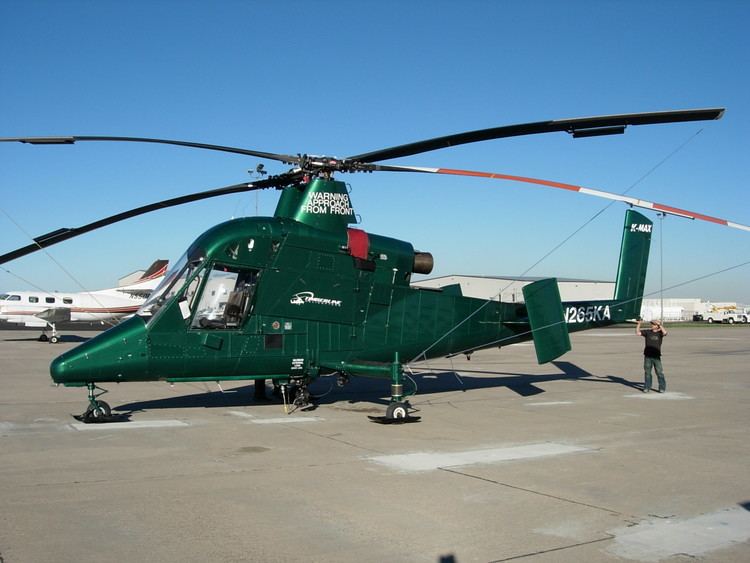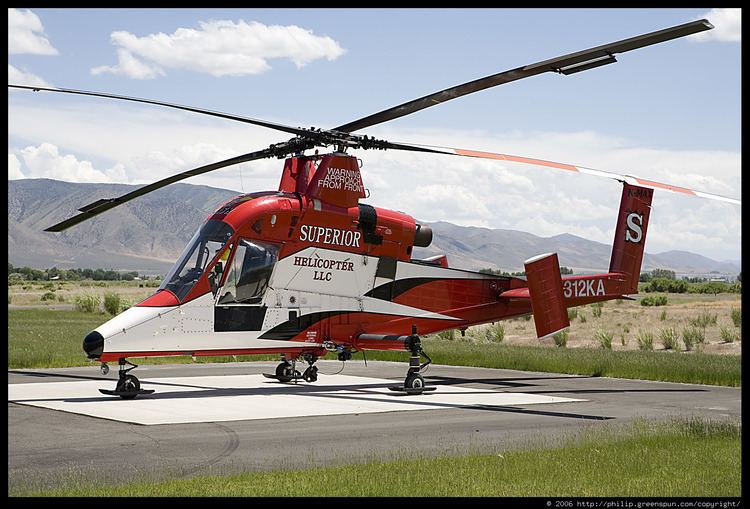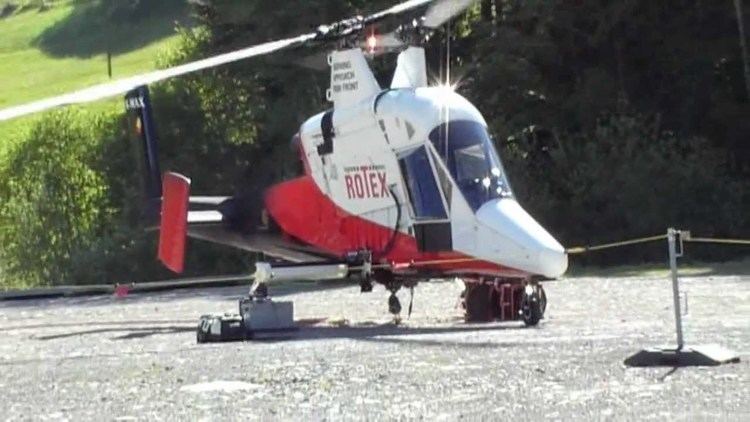Top speed 185 km/h Length 16 m Engine type Lycoming T53 | Range 494 km Wingspan 15 m Manufacturer Kaman Aircraft | |
 | ||
Unit cost 5,000,000–5,000,000 USD (2013), 3,500,000–3,500,000 USD (1996) | ||
Kaman k max helicopter cargo resupply unmanned aircraft
The Kaman K-MAX (company designation K-1200) is an American helicopter with intermeshing rotors (synchropter) by Kaman Aircraft. It is optimized for external cargo load operations, and is able to lift a payload of over 6,000 pounds (2,722 kg), which is more than the helicopter's empty weight. An optionally remote controlled unmanned aerial vehicle version is being developed and is being evaluated in extended practical service in the war in Afghanistan.
Contents
- Kaman k max helicopter cargo resupply unmanned aircraft
- Unique intermeshing rotor helicopter kaman k max landing
- Development
- Unmanned remote control version
- Operators
- Specifications K MAX
- References

In June 2015, Kaman announced restarting the K-MAX production due to 10 commercial orders. First deliveries are planned early 2017.

Unique intermeshing rotor helicopter kaman k max landing
Development

In 1947 Anton Flettner, a German aero-engineer, was brought to the United States as part of Operation Paperclip. He was the developer of the two earlier synchropter designs from Germany during World War II: the Flettner Fl 265 which pioneered the synchropter layout, and the slightly later Flettner Fl 282 Kolibri ("Hummingbird"), intended for eventual production. Both designs used the principle of counter-rotating side-by-side intermeshing rotors, as the means to solve the problem of torque compensation, normally countered in single–rotor helicopters by a tail rotor, fenestron, NOTAR, or vented blower exhaust. Flettner remained in the United States and became the chief designer of the Kaman company. He started to design new helicopters, using the Flettner double rotor.

The K-MAX series are the latest in a long line of Kaman synchropters, the most famous of which is the HH-43 Huskie. The first turbine-powered helicopter was also a Kaman synchropter.

The K-1200 K-MAX "aerial truck" is the world's first helicopter specifically designed, tested, and certified for repetitive external lift operations and vertical reference flight (Kaman received IFR Certification in 1999), an important feature for external load work. Other rotorcraft used for these tasks are adapted from general-purpose helicopters, or those intended to primarily carry passengers or internal cargo. The K-MAX can lift almost twice as much as the Bell 205 using about the same engine. The aircraft's narrow, wedge-shaped profile and bulging side windows give the pilot a good view of the load looking out from either side of the aircraft.
The transmission has a reduction ratio of 24:1 in three stages, and is designed for unlimited life. The rotor blades (turning breaststroke style) are built with a wooden spar and fiberglass trailing edge sections. Wood was chosen for its damage tolerance, fatigue resistance and to take advantage of field experience and qualification data amassed from a similar spar on the HH-43 Huskie helicopter, built for the U.S. Air Force in the 1950s and 1960s. The pilot controls blade pitch with tubes running inside the mast and rotor blades to move servo flaps that pitch the blades, reducing required force and avoiding the added weight, cost and maintenance of hydraulic controls.
The K-MAX relies on two primary advantages of synchropters over conventional helicopters: The increased efficiency compared to conventional rotor-lift technology; and the synchropter's natural tendency to hover. This increases stability, especially for precision work in placing suspended loads. At the same time, the synchropter is more responsive to pilot control inputs, making it possible to easily swing a load, or to scatter seed, chemicals, or water over a larger area.
A K-MAX has been used for demolition work by having a wrecking ball as a slung load.
Thirty-eight K-1200 K-MAX helicopters have been built. As of January 2015, 11 of these were not airworthy or have been written off in accidents, 5 are in Limbo at Kaman, and in March 2015 the number of operational K-MAXes was 21. The production line was shut down in 2003, but may restart if the U.S. Marine Corps orders more autonomous K-MAXs.
In February 2014, Kaman revisited the idea of resuming K-MAX production, having recently received over 20 inquiries for firefighting, logging or industry transport requirements additionally to requests for the military unmanned version. Ten firm orders may convince Kaman to produce K-MAX again. Kaman has received deposits, and if enough orders come through, deliveries could occur by 2017 at a production rate of one per 6-8 weeks. The assembly line re-started in January 2017, and the first new K-MAX is to be delivered later in 2017.
The K-MAX line has flown 300,000 hours as of 2014, and costs $1,200 per flight hour to operate.
Unmanned remote control version
Kaman had been developing the Unmanned K-MAX since 1998. In March 2007, Kaman and Lockheed Martin (Team K-MAX) signed a Strategic Relationship Agreement (SRA) to pursue U.S. DoD opportunities. An unmanned mostly autonomously flying, optionally remote controlled and optionally piloted vehicle (OPV) version, the K-MAX Unmanned Multi-Mission Helicopter was developed for hazardous missions. It can be used in combat to deliver supplies to the battlefield, as well as civilian situations involving chemical, biological, or radiological hazards. A prototype of this was shown in 2008 for potential military heavy-lift resupply use, and again in 2010. In December 2010 the Naval Air Systems Command awarded a $46 million contract to Kaman for two aircraft, and in 2011 they completed a five-day Quick Reaction Assessment.
In December 2011, an unmanned K-MAX was reported to be at work in Afghanistan. On 17 December 2011, the U. S. Marine Corps conducted the first unmanned aerial system cargo delivery in a combat zone using the unmanned K-MAX, moving about 3,500 pounds of food and supplies to troops at Combat Outpost Payne. A third unmanned K-MAX in the U.S. was tested in 2012 to deliver cargo to a small homing beacon with three-meter precision. As of February 2013, the K-MAX had delivered 2 million pounds of cargo in 600 unmanned missions over more than 700 flight hours.
On July 31, 2012, Lockheed announced a second service extension for the K-MAX in Afghanistan for the Marines, then on 18 March 2013 the Marine Corps extended its use of the unmanned K-MAX helicopters indefinitely, keeping the two aircraft in use "until otherwise directed". At the time of the announcement, they had flown over 1,000 missions and hauled over three million pounds of supplies. Assessments for their use after deployment are being studied. The unmanned K-MAX has won awards from Popular Science and Aviation Week & Space Technology, and was nominated for the 2012 Collier Trophy.
On June 5, 2013, one of the unmanned K-MAX helicopters crashed in Afghanistan while resupplying Marines. No injuries occurred and the crash was investigated. Pilot error was ruled out, as the aircraft was flying autonomously to a predetermined point. The crash happened during the final stages of cargo delivery. Operational flights of the remaining unmanned K-MAX were suspended following the crash, with the Navy saying it could resume flying by late August. Swing load was seen as the prime cause. The investigation determined that the crash was not caused by mechanical problems, but by unexpected tailwinds. As the helicopter was making the delivery, it experienced tailwinds instead of headwinds, causing it to begin oscillating. Operators employed a weathervane effect to try and regain control, but its 2,000 lb load began to swing, which exacerbated the effect and caused it to contact the ground. The crash report determined that it could have been prevented if pilots intervened earlier and mission planned received updated weather reports; diverging conditions and insufficient programming meant it could not recover on its own and required human intervention.
At the 2013 Paris Air Show, Kaman promoted the unmanned K-MAX to foreign buyers. Several countries have reportedly expressed interest in the system. The K-MAX supporting Marines in Afghanistan was planned to remain in use there until at least August 2014. The Marine Corps is looking into acquiring the unmanned K-MAX as a program of record, and the U.S. Army is also looking into it to determine cost-effectiveness. In theater, the aircraft performed most missions at night and successfully lifted loads of up to 4,500 lb (2,000 kg). Hook-ups of equipment were performed in concert with individuals on the ground, but Lockheed is looking into performing this action automatically through a device mounted atop the package that the helicopter can hook up to by itself; this feature was demonstrated in 2013. Other features are being examined, including the ability to be automatically re-routed in flight, and to fly in formation with other aircraft. The unmanned K-MAX was successfully able to deliver 30,000 lb (13,600 kg) of cargo were in one day over the course of six missions (average 5,000 lb (2,270 kg) transported cargo per mission). Lockheed and Kaman have discussed the purchasing of 16 helicopters with the Navy and Marine Corps for a baseline start to a program.
The unmanned K-MAX is competing with the Boeing H-6U Little Bird for the Marine Corps unmanned lift/ISR capability. In April 2014, Marines at Quantico announced they successfully landed an unmanned K-MAX, as well as a Little Bird, autonomously using an iPad-like mini-tablet. The helicopters were equipped with Autonomous Aerial Cargo/Utility System (AACUS) technology, which combines advanced algorithms with LIDAR and electro-optical/infrared sensors to enable a user to select a point to land the helicopter at an unprepared landing site. The Office of Naval Research selected Aurora Flight Sciences and the Unmanned Little Bird to complete development of the prototype AACUS system, but Lockheed is continuing to promote the K-MAX and develop autonomous cargo delivery systems.
Both unmanned K-MAX helicopters in use by the Marine Corps returned to the U.S. in May 2014, when the Corps determined that they were no longer needed to support missions in Afghanistan. After deploying in December 2011, originally planned for six months, they stayed for almost three years and lifted 2,250 tons of cargo. The aircraft were sent to Lockheed's Owego facility in New York, while the service contemplated the possibility of turning the unmanned K-MAX from a proof-of-concept project into a program of record. Formal requirements for unmanned aerial cargo delivery are being written to address expected future threats, including electronic attack, cyber warfare, and effective hostile fire; these were avoided in Afghanistan quickly and cheaply by flying at night at high altitudes against an enemy with no signal degradation capabilities. Officials assessed the K-MAX helicopter that crashed and planned to repair it in 2015. The helicopters, ground control stations, and additional equipment are stored at Lockheed's facility in Owego. The two unmanned K-MAXs, designated CQ-24A, were to be moved to a Marine Corps base in Arizona by the end of September 2015 to develop tactics and operations concepts to inform an official program of record for a cargo UAV.
Lockheed Martin demonstrated a fire fighting version in November 2014, and again in October 2015, when it delivered over 24,000 pounds (11,000 kg) water in one hour. A casualty evacuation exercise was performed in March 2015 in coordination with an unmanned ground vehicle and mission planning system. A medic launched the UGV to evaluate the casualty, used a tablet to call in and automatically land the K-MAX, then strapped a mannequin to a seat aboard the helicopter.
Operators
Specifications (K-MAX)
Data from K-MAX performance and specs
General characteristics
Performance
